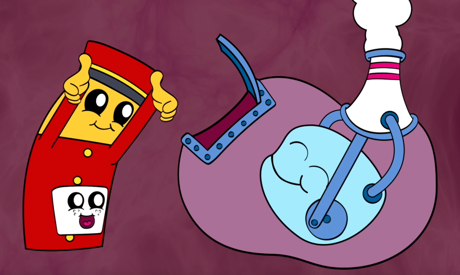

We need to increase awareness about Diabetes
To eliminate stigma
Several diseases with the same name – it’s not strange the people get confused. Beat Diabetes Foundations purpose is to lead the fight against diabetes, and we therefore must inform and educate about the different types of diabetes. This to eliminate stigma and to increase awareness about the diseases.
What is Type 1 Diabetes?
Diabetes type 1 is a disease that can be developed in all ages but is usually diagnosed on children, teens, and young adults. Currently the scientists don’t know the cause of the disease, nor either how to prevent it. Diabetes type 1 can be managed by injecting insulin through an insulin-pen or a pump, following the doctors’ recommendations, managing their blood sugar levels, and getting regular health check-ups.
A person with type 1 diabetes meaning that their pancreas doesn’t produce any or makes very little insulin. Insulin is a hormone that helps the blood glucose enter the cells in your body, like keys, where it can be used for energy. Without insulin, the sugar in your blood is unable to enter the cells and builds up in the bloodstream. Going with a high blood sugar is dangerous for the body and causes a lot of complications for a person with diabetes.
People with Diabetes type 1 must therefore inject insulin externally to managing their blood sugar every time when their glucose levels are too high.
Diabetes type 1 in the Nordics has the highest diagnosed numbers per capita in the world. Only in Sweden there is 900 children and as many adults that gets affected of the disease every year and more than 50.000 people is diagnosed – but no one can be cured. The correlative number for type 2 diabetes in Sweden is 450 000 but there is a huge hidden number for that disease.
Symptoms of Type 1 Diabetes
Type 1 Diabetes can develop in just a few weeks or months. Some symptoms or signs are similar to other health conditions but don’t guess. If you start to develop any of these symptoms, make sure to get to the doctor to test your glucose levels
- You feel very thirsty and urinate often
- You feel tired and week
- You feel nausea
- Your stomachache
- Your breath smells
- You can see blurred and get visual disturbances
- You lose weight very quickly
Managing your Diabetes
Living with Diabetes meaning that you need to check your blood sugar levels regularly, every morning, before every meal, every activity basically before and after everything you do –which can be hard. Diabetes type 1 is a tough disease to cope with, not only for the person themselves but also for the people around them. Diabetes is mostly controlled by you, but your doctor will assist to help you figure out the most effective type and dosage of insulin for you.
You can live a good and active life, despite diabetes. It might take time to get used to your new life and to accept the disease. Most people find it difficult in the beginning to have a constant check of your glucose levels and taking insulin and base the doses depending of physical activity, infections, sleep, food and many other factors. But with time will this be a natural part of your life.
Most of all people living with Diabetes type 1 has access to continuous glucose monitoring, called CGM. That means that they don’t need to check their glucose levels through capillary finger pricks and can monitor their levels on their phones or devices.

What is Type 2 Diabetes?
When it comes to Diabetes type 2, there are primarily two interrelated problems. One is that your pancreas does not produce enough insulin, the hormone that regulates the movement of sugar into your cells and secondly that the cells poorly respond to insulin and takes in less sugar. Diabetes type 2 is mostly a disease caused by an unhealthy lifestyle but can be prevented with physical activity, eating healthy and prevent obesity. Other factors are to sleep well and to avoid too much stress.
Previously Diabetes type 2 was called “elderly-diabetes” saying that only elderly people developed the disease. Type 2 is more common with older adults, but the increasing numbers among kids with obesity has led to more cases of type 2 diabetes even in young ages.
There is no cure for Diabetes type 2, but losing weight, eating healthy and to live a healthy lifestyle help’s you manage the disease. If diet and exercise is not enough to help you manage your glucose levels, you might need medications or insulin therapy.
Symptoms of Diabetes type 2
The glucose levels in your bloodstream increases very slowly and you don’t get the rapidly increased symptoms and signs as when you develop type 1 diabetes. In fact, you can be living with type 2 diabetes for years without knowing. When signs and symptoms are present, they may include:
- Increased thirst
- Frequent urination
- Increased hunger
- Unintended weight loss
- Fatigue
- Blurred vision
- Slow-healing sores
- Frequent infections
- Numbness or tingling in the hands or feet
- Areas of darkened skin, usually in the armpits and neck
Similarities between different types of Diabetes
The similarities between the different types of the diseases going under the name “Diabetes” is that there is too much sugar in the blood stream. If you have high levels of sugar in the blood during a long period will this, give you damages on tissues, especially the blood vessels. Organs with very thing vessels is more affected than others. Such as kidneys, the fundus, coronary arteries in the heart.
Why is exercise important?
Physical exercise is important for all people though this has a positive impact of all organs, especially for the brain, skeleton, and the heart. Physical activity also increases the insulin sensitivity which is mainly important for people with type 2 diabetes.
Sugar saves lives!
A person with diabetes that has a low blood sugar can seem to be confused, affected on anything, get cramps, or loses consciousness:
- Give sugar in any form as possible! i.e., honey, soda with sugar, fruit, or candy if the person is awake
- Call 112
- Don’t give insulin!


